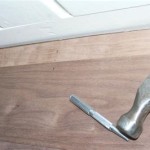How To Install Laminate Wood Flooring Around Doors And Windows
Installing laminate wood flooring can significantly enhance the aesthetic appeal and value of a property. While laying the main floor area is relatively straightforward, navigating the intricacies around doorways and windows presents unique challenges. A precise and meticulous approach is crucial to achieving a professional finish that seamlessly integrates with these architectural features. This article provides a comprehensive guide to installing laminate flooring around doors and windows, ensuring a flawless and durable result.
Preparing the Subfloor and Gathering Necessary Tools
Prior to commencing the laminate installation, the preparation of the subfloor is paramount. The subfloor must be clean, level, and dry. Any existing flooring, such as carpet, tile, or vinyl, needs to be completely removed. Vacuum the entire area thoroughly to eliminate dust, debris, and any loose particles. Inspect the subfloor for any irregularities or damage. If there are low spots, use a self-leveling compound to create a smooth and even surface. For significant imperfections, consider applying a layer of plywood or underlayment.
Once the subfloor is properly prepared, gather all the necessary tools and materials. This typically includes: laminate flooring planks, underlayment (if not already attached to the planks), a t-square, a measuring tape, a pencil, a circular saw or jigsaw, a tapping block, a pull bar, spacers, a rubber mallet, safety glasses, and a dust mask. A jamb saw or oscillating multi-tool is particularly useful for trimming door casings and window sills, allowing the laminate to slide underneath for a cleaner finish. Selecting the correct type of underlayment is also important. Some underlayments offer moisture resistance, sound dampening, and insulation, depending on the specific needs of the room and the type of subfloor.
The selection of the laminate flooring itself is a crucial step. Choose a product that is appropriate for the intended use and location. Consider factors such as the thickness of the planks, the wear layer, and the water resistance rating. Thicker planks generally offer greater durability and stability, while a thicker wear layer provides increased protection against scratches and dents. For areas prone to moisture, such as bathrooms or kitchens, select a water-resistant laminate flooring.
Acclimation of the laminate flooring is also essential for optimal performance. Store the unopened boxes of flooring in the room where they will be installed for at least 48 to 72 hours prior to installation. This allows the laminate to adjust to the room's temperature and humidity levels, minimizing the risk of expansion or contraction after installation.
Accurate Measurement and Marking for Precise Cuts
The key to a seamless installation around doors and windows lies in accurate measurement and precise cutting. Begin by determining the direction in which the laminate planks will be laid. Typically, running the planks parallel to the longest wall creates a more visually appealing and spacious effect. Start by laying a row of planks along the longest wall, leaving an expansion gap of approximately ¼ to ⅜ inch between the planks and the wall. Use spacers to maintain this consistent gap. This expansion gap is crucial to accommodate the natural expansion and contraction of the laminate due to changes in temperature and humidity.
When approaching doorways and windows, meticulous measurements are required. Use a measuring tape to determine the exact distance from the edge of the last full plank to the door casing or window sill. Transfer this measurement to a new plank, ensuring that you account for the expansion gap. Use a t-square to create a straight line across the plank, and then use a circular saw or jigsaw to make the cut. Safety glasses and a dust mask should be worn during the cutting process to protect your eyes and respiratory system.
For areas where the laminate needs to fit snugly around door casings or window sills, use a template or contour gauge to accurately replicate the shape. Place the template or contour gauge against the door casing or window sill, and trace the shape onto the plank. Use a jigsaw to carefully cut along the traced line. It is often better to cut slightly larger than necessary and then gradually trim the laminate until it fits perfectly. Precision is paramount in this step, as even small gaps can detract from the overall appearance of the finished floor.
When dealing with window sills that extend to the floor, consider using a jamb saw or oscillating multi-tool to undercut the sill. This allows the laminate to slide underneath the sill, creating a clean and professional look. Measure the thickness of the laminate and underlayment to determine the appropriate depth for the undercut. Carefully cut along the bottom edge of the sill, removing enough material to accommodate the laminate. After installing the laminate, apply a bead of caulk along the edge of the sill to seal the gap and prevent moisture from seeping underneath.
Installing Laminate Around Door Frames and Window Sills
Installing laminate around door frames requires careful attention to detail. One common approach is to use a jamb saw to undercut the door frame, allowing the laminate to slide underneath. This provides a clean and professional finish, eliminating the need for unsightly gaps or molding. Measure the thickness of the laminate and underlayment to determine the appropriate depth for the undercut. Use a jamb saw or oscillating multi-tool to carefully cut along the bottom edge of the door frame, removing enough material to accommodate the laminate.
After undercutting the door frame, slide the laminate plank into place, ensuring that it fits snugly against the frame. Use a tapping block and pull bar to gently tap the plank into position, ensuring that it is securely locked into the adjacent planks. Maintain the expansion gap along the edges of the floor, using spacers as needed. If necessary, trim the laminate plank to achieve a perfect fit. A sharp utility knife can be used to make small adjustments.
For window sills that do not extend to the floor, the same principles apply. Measure the distance from the edge of the last full plank to the window sill, and transfer this measurement to a new plank. Use a t-square to create a straight line across the plank, and then use a circular saw or jigsaw to make the cut. Carefully fit the plank around the window sill, ensuring that it is securely locked into the adjacent planks. Use a tapping block and pull bar to gently tap the plank into position.
When dealing with irregularly shaped door frames or window sills, consider using a flexible molding or trim to conceal any gaps. Flexible molding can be easily bent and shaped to conform to the contours of the frame or sill, providing a seamless and professional finish. Apply the molding using construction adhesive or small finishing nails. Caulk can also be used to fill any small gaps and create a watertight seal.
After installing all the laminate planks around the door frames and window sills, inspect the area carefully to ensure that there are no gaps or imperfections. Use a rubber mallet to gently tap any planks that are not fully locked into place. Apply a bead of caulk along the edges of the floor and around the door frames and window sills to seal any gaps and prevent moisture from seeping underneath. This will also help to prevent drafts and improve the energy efficiency of the room.
The final step is to install baseboards or quarter-round molding along the perimeter of the room. This will conceal the expansion gap and provide a finished look. Choose a baseboard or molding that complements the laminate flooring and the overall style of the room. Attach the baseboard or molding to the wall using finishing nails or construction adhesive. Caulk can be used to fill any small gaps between the baseboard or molding and the wall. With careful preparation, accurate measurements, and precise cuts, it is possible to achieve a professional and durable laminate flooring installation around doors and windows.

How To Finish Vinyl Plank Exterior Doors Installation

Determining The Direction To Lay Install Hardwood Laminate Or Luxury Vinyl Plank Flooring

Why We Love To Install Laminate Flooring Bright Green Door

How To Install A Laminate Floor

How To Install Vinyl Plank Flooring Around Door Jambs Of A Closet Step By Diy

Guide To Installing Laminate Flooring Diy Family Handyman

How To Install Laminate Flooring On Your Own Diy Hq Longwood Fl

6 Steps For Installing Laminate Flooring The Home Depot

Pro Tips And Tricks For Installing Laminate Flooring Family Handyman

How To Install Laminate Flooring Beading
Related Posts








